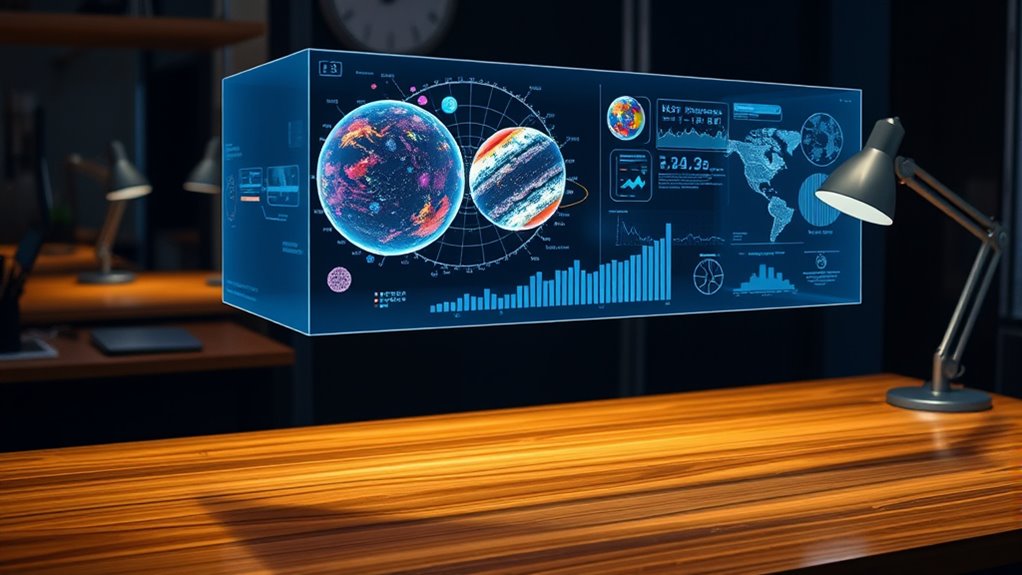Holographic displays are becoming a reality for your desk, thanks to advances in light manipulation and augmented reality technology. They project 3D images that you can view from multiple angles without glasses, creating immersive and interactive digital environments. Improved compact projectors and lightweight AR glasses are making these systems more accessible and practical for everyday use. As this technology evolves, you’ll see more lifelike visuals integrated into your workspace or home—keep exploring to learn how this transformation unfolds.
Key Takeaways
- Advances in light manipulation enable real-time, glasses-free 3D images viewable from multiple angles.
- Compact projectors and lightweight AR glasses are making holographic displays practical for desktop use.
- Improved light-emitting components produce crisp, stable holograms suitable for everyday environments.
- Integration of holography enhances immersive interactions, reducing reliance on flat screens in work and entertainment.
- Ongoing technological progress aims to bring lifelike, accessible holographic displays into homes and offices.

Have you ever wondered how future technology might make images appear to float in midair? That’s exactly the promise behind holographic displays, which are rapidly shifting from science fiction to the desk setup. These displays leverage cutting-edge advancements in augmented reality and 3D visualization, creating immersive visual experiences right in your workspace or living room. Unlike traditional screens, holographic displays project three-dimensional images that you can view from multiple angles, making the digital world feel more tangible and interactive.
At their core, holographic displays utilize complex light manipulation to produce images that seem to hover in space. This involves precise control over light sources and sophisticated optics to generate 3D visuals that don’t require special glasses. This is where augmented reality plays a vital role. By integrating AR techniques, holographic systems can overlay digital images onto real-world environments seamlessly. Imagine pointing your device or wearing lightweight AR glasses, and instantly, digital models or information appear floating in your field of view. This fusion of real and virtual elements enhances understanding, especially in fields like design, medical imaging, or education.
3D visualization is essential in making holographic displays effective. Instead of flat images, holography provides depth and spatial relationships, giving you a sense of volume and position. This allows for more intuitive interactions—rotating a 3D model, examining it from different angles, or even manipulating it with your hands. The result is a more natural way to engage with digital content, reducing reliance on flat screens and making interfaces more immersive. As technology advances, holographic displays are becoming smaller, more affordable, and more capable of integrating seamlessly into everyday devices.
Recent developments make it feasible to bring holography from high-end labs into your home or office. Researchers are working on compact projectors, lightweight AR glasses, and improved light-emitting components that can produce crisp, stable images in real-time. These innovations aim to make holography practical for daily use, whether for gaming, remote collaboration, or professional visualization. You’ll soon be able to see 3D holograms without bulky equipment, transforming how you work, learn, and entertain yourself.
In essence, holographic displays are no longer confined to sci-fi movies. Thanks to breakthroughs in augmented reality and 3D visualization, you’re on the brink of experiencing digital content in a way that’s more lifelike and engaging. As these technologies continue to evolve, holography will become a natural part of your digital environment—making images float effortlessly in space, right before your eyes. Moreover, advances in projector technology are making it easier to bring holographic visuals into everyday use, making these displays more accessible and practical for various applications.
Frequently Asked Questions
How Long Will Holographic Displays Take to Become Affordable?
You might wonder when holographic displays will become affordable. While cost reduction efforts are underway, manufacturing challenges still slow down mass production and price drops. As technology advances and companies improve manufacturing processes, prices will steadily decrease. Expect it to take several years before holographic displays become budget-friendly for everyday users, but ongoing innovation suggests affordability is on the horizon. Patience and continued investment will bring these futuristic displays within reach.
Are There Health Concerns With Prolonged Holographic Display Use?
You might wonder if prolonged holographic display use causes health issues. While research is ongoing, concerns like eye strain and visual fatigue are common, especially if you use these displays for hours without breaks. To protect your eyes, take regular breaks, adjust brightness, and maintain proper distance. As technology advances, manufacturers are also focusing on reducing these risks, making holographic displays safer for everyday use.
Can Holographic Displays Support Interactive Multi-User Experiences?
Yes, holographic displays can support interactive multi-user experiences. By leveraging gesture control, you can easily manipulate holograms, while spatial mapping guarantees accurate positioning of virtual objects in real space. This allows multiple users to interact seamlessly, collaborate, or share information simultaneously. As technology advances, these features will become more intuitive, making holographic displays a powerful tool for group work, gaming, and immersive learning.
What Are the Power Consumption Levels of Holographic Display Devices?
You’ll find that holographic display devices vary in power consumption, but advancements focus on energy efficiency and power management. Modern models are designed to minimize energy use while maintaining high-quality visuals, making them more sustainable and practical for daily use. By optimizing hardware and software, manufacturers help you reduce power consumption, ensuring these innovative displays are both mesmerizing and efficient, fitting seamlessly into your workspace or entertainment setup.
Will Holographic Displays Replace Traditional Monitors Entirely?
You might wonder if holographic displays will fully replace traditional monitors. While they’re advancing with augmented reality and virtual interfaces, they’re unlikely to completely replace your current screens soon. Holographic tech enhances interaction and immersion, but for now, they complement rather than replace traditional monitors. As technology evolves, you’ll see more seamless integration, making virtual interfaces a natural part of your workspace without entirely discarding your familiar screens.
Conclusion
You’re witnessing a tech revolution—holographic displays are becoming more than sci-fi dreams, now fitting right onto your desk. With advancements increasing display resolution by over 50% in just the past year, these holograms are sharper and more realistic than ever. Imagine collaborating with 3D models floating in mid-air or viewing immersive data visualizations effortlessly. As this technology progresses, it’s clear holographic displays will soon transform how you work, learn, and communicate, making the future more interactive and visually stunning.









